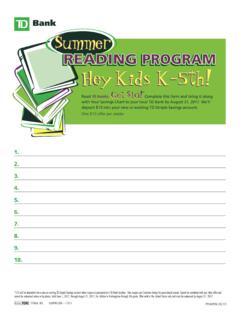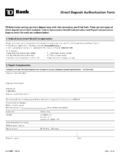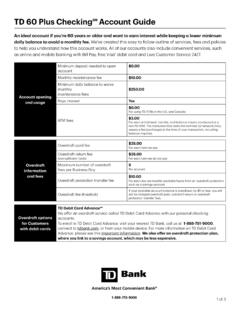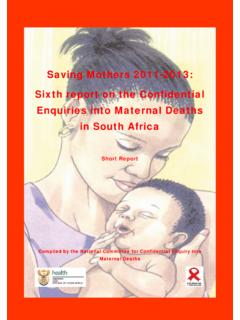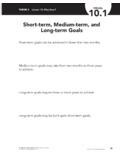Transcription of AN INTRODUCTION TO SAVING AND SPENDING
1 Grades K-1 Lesson 1 AN INTRODUCTION TO SAVING AND SPENDING Key concepts: Role of banks in an economy; SAVING money Summary: This lesson will help students understand why SAVING money is important. Students will be able to list some benefits of SAVING and create a simple savings plan. NJ Core Curriculum Content Standards in Personal Financial Literacy: Standard 9: 21st Century Life and Careers B. Money Management: , , D. Planning, SAVING , and Investing: National Standards in K 12 Personal Finance Education (from Jump$tart Coalition): Planning and Money Management: Standard 1, Develop a plan for SPENDING and SAVING . SAVING and Investing: Standard 1, Discuss how SAVING contributes to financial well-being. National Content Standards in Economics (from Council for Economic Education): Standard 11, Money, specifically coins and currency Rationale: This lesson is intended for elementary students in kindergarten through first grade during a thirty minute time period.
2 The lesson fosters a desire to save money among students by way of tasks that consider the rewards of SAVING . The lesson also encourages students to use a balance when they need to decide how much money to save and spend. The activities rely on a variety of interactive and visual formats designed to be interesting and fun. Lesson Objectives: Students will be able to: Explain why it is important to save. Recognize the benefits of SAVING money at the bank. Create a plan to save for a designated item. Materials: Enough coins and small items to provide two per student TD Bank WOW! Zone 1 Grades K-1/Lesson 1 Labels from appealing treats to show children Resource Files: Game Wheel A, Game Wheel B, Coins Drawing activity page *Materials not attached to this file may be found in a separate resource file.
3 Setting the Stage: Background Builder #1: Give each student a coin (real or pretend) and allow each student to decide whether they would like to spend it now on a small item you have provided. Mention that if they save their coin until the end of the lesson they may be able to buy something better. At the end of the lesson, give a second coin to all those students who saved the first coin as interest. They should be allowed to buy two things. Point out why it is a good idea to save; you earn extra money, and you can afford things that cost more money. (If you use candy or food as an incentive, please be aware of any allergies students may have.) Background Builder #2: Select four students and hand each a coin page.
4 Have those four students stand in front of the room showing the class each coin. Have the coins placed in order according to value. Children will need guidance because at this age they may order them by size as all coin values are not necessarily introduced or mastered just yet. Emphasize that some coins are worth more and some are worth less, so some will buy more while some will buy less. Remember to tell students where to place the least and most valuable coins because the concept of left and right isn t usually mastered yet either. Students may also practice this activity in small groups. Background Builder #3: Show some actual items or labels from tasty treats young children love to eat (pizza, chicken nuggets, tacos, Lunchables, bubble gum, candy bars, fruit roll-ups, nacho chips, etc.)
5 Separate the snack items into two groups and label them as either under $1 or over $1. Tell them you have less than a dollar, but you want something from the group that costs more than $1. Ask them for ideas so you will soon be able to buy what you want. Welcome all ideas, but guide them toward the idea of SAVING . State the Objective: tell the students what they will be able to do upon conclusion of the lesson. Before the end of this lesson, you should be able to explain why SAVING is important. You should also decide that it s a good idea to save a certain amount every time you receive money. The Lesson Procedure: TD Bank WOW! Zone 2 Grades K-1/Lesson 1 Ask/discuss the following questions: What does it mean to save something?
6 What are some things you save? Why do you think it is important to save? Check for Understanding: Why is it important to save? Why shouldn t you save all of your money? (You might have to buy lunch!) Why should you save your money in a bank? (Safety and Interest) Guided Practice: Inform students that you re going to play a game to see if they can determine which amount would be best to save in order to buy an expensive item in the future. The game is called Wheel and Deal . A student will spin the wheel you choose as more appropriate for the level of your group and earn a coin. Then he/she will spin the wheel a second time to earn a second coin.
7 The spinner predicts the type of coin earned. The student has to decide which coin would be best to keep. The goal is to save the most money. You won t have enough time to give everyone a turn during the lesson, so this will be a great game to employ as a learning center/station within your classroom. Closing the Lesson: Tell students you d like them to make a decision today on why to save money. They should think of an item for which they have a desire to buy. Then have pupils draw a picture of that item, look at it, and decide how to save in order to afford it. Given that all students aren t able to write the plan at this age, they can simply share the plan with a fellow student, try to write it on their own, draw a picture to represent their plan, or they can relay it to the teacher who will assist in writing the ideas.
8 National Council of Teachers of Mathematics Principles and Standards for School Mathematics, 2008. Number and Operations (Students will) Understand numbers, ways of representing numbers, relationships among numbers, and number systems. Algebra (Students will) Understand patterns, relations, and functions. Data Analysis and Probability (Students will) Formulate questions that can be addressed with data and collect, organize, and display relevant data to answer them. Communication (Students will) Organize and consolidate their mathematical thinking through communication. Connections (Students will) Recognize and use connections among mathematical ideas. TD Bank WOW! Zone 3 Grades K-1/Lesson 1
